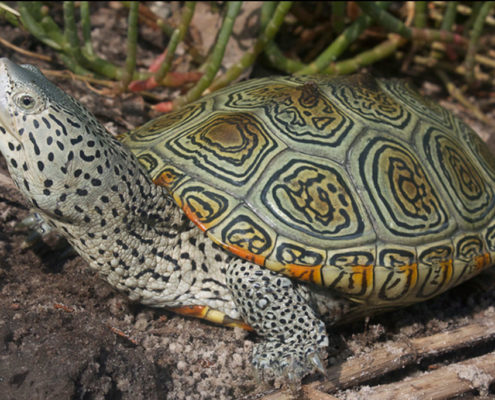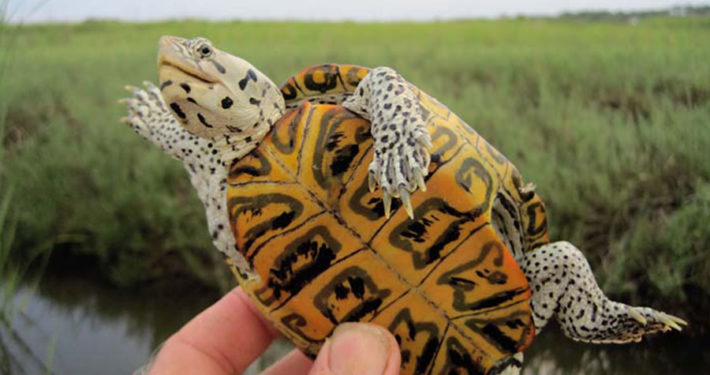Northern Diamondback Terrapin
Description
The Northern Diamondback Terrapin (Malaclemys terrapin) is a medium-sized salt marsh turtle that inhabits the coastal marshes of Massachusetts for its entire life. It is the only turtle in North America who can survive in brackish and salty waters. The name "terrapin" is derived from the Algonquian word, “torope” (“little turtle”) and was originally used by early European settlers in North American to describe those turtles who lived in neither the sea nor freshwater bodies of water.
Both sexes have grayish to black skin, spotted with dark green flecks, and light-colored upper and lower jaws. The terrapin’s hind feet are large, paddle-like, and strongly webbed. Adult females are the size of a dinner plate, ranging from 15-23 cm (6-9 in.) in length, considerably larger than males, who are 10-15 cm (4-6 in.). Hatchlings look like adults and are about 2.6 cm (1 in.) long.
Northern Diamondback Terrapins exclusively inhabit coastal salt marshes, estuaries, tidal creeks and ditches with brackish water (a mix of both salt and freshwater) which is bordered by spartina grass. They are the only turtle in the world that is specially adapted to spend its entire life in this type of water. Studies have shown that terrapins exhibit a high level of site fidelity or they return to the same territory every year.
They also have a very small home range and some occupy the same small creeks year after year. Northern Diamondbacks are found along the Atlantic Coast, from Massachusetts south to Florida, and along the Gulf coast from the Carolinas to Texas.
Northern Diamondback Terrapins primarily feed on crustaceans such as small crabs, snails, and mollusks. Terrapins are predators of salt marsh snails that feed on salt marsh cordgrass; if terrapins and other predators are removed, the salt marsh snails overgraze the cordgrass and leave mudflats barren, thus terrapin populations are essential for healthy salt marsh ecosystems. Natural predators include raccoons, large crabs, fish, and seagulls. Raccoons, in particular, are known to be significant predators of terrapins and can prey upon 90% of nests where they overlap in coastal habitats.
Northern Diamondback Terrapins are cold-blooded, hibernating during the winter at the bottom of estuaries, creeks, and salt marsh channels. They always have some mud covering them. Adult terrapins mate in early spring, gathering together in small, quiet coves along the coast. Salt marshes are critical wintering, foraging, and nursery areas.
Egg-carrying females will make the journey upland and sometimes inland as much as a 0.4 km (1/4 mile) to lay eggs. Females lay clutches of 8-12 eggs from early June into mid-July in sandy beaches and other upland gravel areas that are above the high tide line. The eggs hatch in 61-104 days. The warmer the soil, the faster they hatch, however only approximately 1-3% of the eggs laid actually produce a hatchling; success rates of young reaching adulthood are also low.
Hatchlings laid later in the year sometimes overwinter in nests and emerge the following April. After hatching, they immediately head for vegetation, which helps provide cover and protection from predators, like gulls and crows.
Males reach maturity at 5-8 years in age or when they are around 3-3.5" in length, while females reach maturity at 9-10 years in age or when they are around 6.5" in length and weigh 2.3 lbs.
Additional Info
Recreational and commercial crab pots threaten terrapin populations by unintentional capture and drowning. Additionally, habitat destruction poses a serious and ongoing threat to terrapin populations as this species’ range is coincident with dense areas of the human population on the North American coast.
Human development bordering coastal marshes and shorelines also have negative impacts, especially where terrapins occur in low numbers. Roadside fences have been successful to prevent road mortality, however other coastal anthropogenically-engineered structures, such as bulkheads on beaches, prevent terrapin access to dune nesting habitat.
Increased erosion from sea-level rise, storm surge, and human activities will likely alter this species’ habitat. Sea level rise, flooding, and storm surge events have a very high likelihood of disrupting nesting habitat and negatively influencing salt marsh food webs that support terrapin populations throughout their life cycles.










